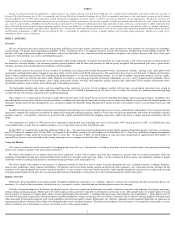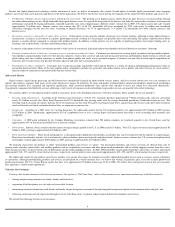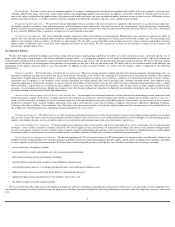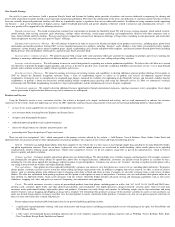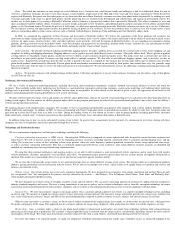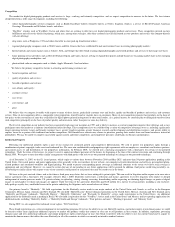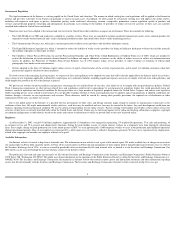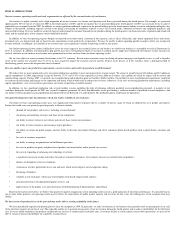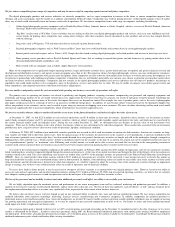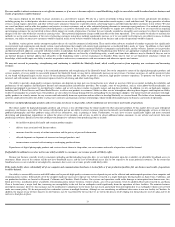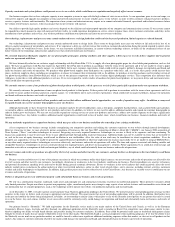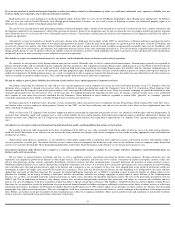Shutterfly 2008 Annual Report Download - page 14
Download and view the complete annual report
Please find page 14 of the 2008 Shutterfly annual report below. You can navigate through the pages in the report by either clicking on the pages listed below, or by using the keyword search tool below to find specific information within the annual report.
ITEM 1A. RISK FACTORS
Our net revenues, operating results and cash requirements are affected by the seasonal nature of our business.
Our business is highly seasonal, with a high proportion of our net revenues, net income and operating cash flows generated during the fourth quarter. For example, we generated
approximately 52% of our net revenues for 2007 in the fourth quarter of 2007, and the net income that we generated during the fourth quarter of 2007 was necessary for us to achieve
profitability on an annual basis for 2007. In addition, we incur significant additional expenses in the period leading up to the fourth quarter holiday season in anticipation of higher sales
volume in that period, including expenses related to the hiring and training of temporary workers to meet our seasonal needs, additional inventory and equipment purchases and
increased advertising. If we are unable to accurately forecast and respond to consumer demand for our products during the fourth quarter, our financial results, reputation and brand will
suffer and the market price of our common stock would likely decline.
In addition, we base our operating expense budgets on expected net revenue trends. A portion of our expenses, such as office, lab facility, and various equipment leases and various
personnel costs, are largely fixed and are based on our expectations of our peak levels of operations. We may be unable to adjust spending quickly enough to offset any unexpected
revenue shortfall. Accordingly, any shortfall in net revenues may cause significant variation in operating results in any quarter.
Our limited operating history makes it difficult to assess the exact impact of the seasonal factors on our business or whether our business is susceptible to cyclical fluctuations in
the U.S. economy. In addition, our historically rapid growth may have overshadowed whatever seasonal or cyclical factors might have influenced our business to date. Seasonal or
cyclical variations in our business may become more pronounced over time and may harm our future operating results.
We are also subject to macro-economic fluctuations in the U.S. economy. Recent macro-economic issues involving sub-
prime mortgages and liquidity issues, as well as liquidity
issues in the auction rate securities that we invest in, may negatively impact the economy and our growth. If these issues persist, or if the economy enters a prolonged period of
decelerating growth, our results of operations may be harmed.
If we are unable to meet our production requirements, our net revenues and results of operations would be harmed.
We believe that we must significantly grow our current production capability to meet our projected net revenue targets. We expect to spend between $43 million and $47 million in
capital expenditures in 2008, representing a range of between 17.5% and 18.5% of our expected fiscal year 2008 net revenues, and a portion of which we expect will be used to add
manufacturing capacity. During, 2007, we opened a new manufacturing and production plant in Charlotte, North Carolina. Our inability to meet our production requirements could lead
to customer dissatisfaction and damage to our reputation and brand, which would result in reduced net revenues. Moreover, if the costs of meeting production requirements, including
capital expenditures, were to exceed our expectations, our results of operations would be harmed.
In addition, we face significant production risks at peak holiday seasons, including the risks of obtaining sufficient qualified seasonal production personnel. A majority of our
workforce during the fourth quarter of 2007 was seasonal, temporary personnel. We have had difficulties in the past finding a sufficient number of qualified seasonal employees, and
our failure to obtain qualified seasonal production personnel both in our Hayward, CA and Charlotte, NC production plants could harm our operations.
Our quarterly financial results may fluctuate, which may lead to volatility in our stock price.
Our future revenues and operating results may vary significantly from quarter-to-
quarter due to a number of factors, many of which are difficult for us to predict and control.
Factors that could cause our quarterly operating results to fluctuate include:
Based on the factors cited above, we believe that quarter-to-
quarter comparisons of our operating results are not a good indication of our future performance. It is possible that in
one or more future quarters, our operating results may be below the expectations of public market analysts and investors. In that event, the trading price of our common stock may
decline.
We have incurred operating losses in the past and may not be able to sustain profitability in the future.
We have periodically experienced operating losses since our inception in 1999. In particular, we make investments in our business that generally result in operating losses in each
of the first three quarters of our fiscal year. This typically enables us to generate the majority of our net revenue during the fourth quarter and to achieve profitability for the full fiscal
year. If we are unable to produce our products and provide our services at commercially reasonable costs, if revenues decline or if our expenses exceed our expectations, we may not be
able to sustain or increase profitability on a quarterly or annual basis.
•
demand for our products and services, including seasonal demand;
•
our pricing and marketing strategies and those of our competitors;
•
our ability to attract visitors to our website and convert those visitors into customers;
•
our ability to retain customers and encourage repeat purchases;
•
our ability to sustain our profit margins, and our ability to diversify our product offerings and sell to consumers photo-
based products such as photo books, calendars and
cards;
•
the costs of customer acquisition;
•
our ability to manage our production and fulfillment operations;
•
the costs to produce our prints and photo
-
based products and merchandise and to provide our services;
•
the costs of expanding or enhancing our technology or website;
•
a significant increase in returns and credits, beyond our estimated allowances, for customers who are not satisfied with our products;
•
declines or disruptions to the travel industry;
•
variations in weather, particularly heavy rain and snow which tend to depress travel and picture taking;
•
the timing of holidays;
•
volatility in our stock price, which may lead to higher stock
-
based compensation expense;
•
consumer preferences for digital photography services; and
•
improvements to the quality, cost and convenience of desktop printing of digital pictures and products.


